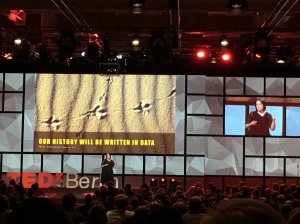 On Sunday, I had the opportunity to discuss my latest research on image intelligence at TEDxBerlin; today I spoke about it at the IFA+ Summit. It’s inspiring to look at technology through two separate lenses: one that is aspirational and shows us a little about what the future may bring, and one that is more practical and focused on real-world implications.
On Sunday, I had the opportunity to discuss my latest research on image intelligence at TEDxBerlin; today I spoke about it at the IFA+ Summit. It’s inspiring to look at technology through two separate lenses: one that is aspirational and shows us a little about what the future may bring, and one that is more practical and focused on real-world implications.
I’d seen Patrick Meier speak before, but watching him as he taught Nepalis to guide UAVs (drones) into areas of the country that were devastated and rendered inaccessible after the earthquake was deeply moving.
Nonny de la Peña, who did a fantastic talk at TED Women a while back, is using virtual reality to bring people into news stories in ways that are not only innovative but deeply affecting.
James Beacham, an experimental high-energy particle physicist with the ATLAS Collaboration at the Large Hadron Collider at CERN, talked about what happened when he didn’t find a new particle.
Gloria Spindle, a member of the artist and activist group known as the Peng! Collective, discussed some of the work/performance art her group has executed: fake Google ads, a self-help program for spies, and dozens of other provocations.
At IFA+, the tone was a bit more pragmatic, but nonetheless inspiring. I really enjoyed my co-presenters’ talks on potential use cases for Blockchain (by Mark van Rijmenan), on privacy-safe search (by Jean-Baptiste Piacentino), and on the future of media analytics (by Dr. Stefan Wrobel).
What these talks had in common was a commitment to learning, understanding and pushing the boundaries of the digital world we occupy. Here’s what I came away with:
1. Being right isn’t always the most valuable outcome
Dr. Beacham talked about the crossroads at which he found himself after finding possible evidence of a new particle. One one path, a Nobel Prize. On the other, more data and more learning. If a world-renowned particle physicist can get up on stage and talk compellingly about failure, we can learn from our mistakes.
2. Sometimes the most important truths are right beneath our discomfort
Look at Peng!’s work. Can art make people rethink conventional wisdom and biases? Every single day; it’s just that sometimes we learn that in retrospect.
3. Technology can be deeply humane
The work of Patrick Meier and Nonny de la Peña show what happens when we use technology as a tool for humanity, not an escape from it. Can drones be used for war? Yes, but they can also be used as a lifeline for remote populations and for countless other uses, both humanitarian and commercial. De la Peña’s work reminds us that VR isn’t just for gamers; it can be an entirely new way of experiencing the digital world.
On a cross-country flight years ago, I watched Steven Johnson’s TED talk, “Where Good Ideas Come From”. Even in my jetlagged stupor, I remember being inspired by the story he told about what sparked innovation during the Enlightenment. Were people smarter? Probably not. What make so many advances possible? Coffee, or rather, coffee houses. People—artists, scientists, writers, politicians—met in these public spaces and shared ideas that influenced each others’ thinking.
Even in a world that’s so profoundly digital, I’m inspired by this idea, and by the curators who, in physical and digital spaces, are bringing together the people who will help us make sense of the incredible time we live in.
